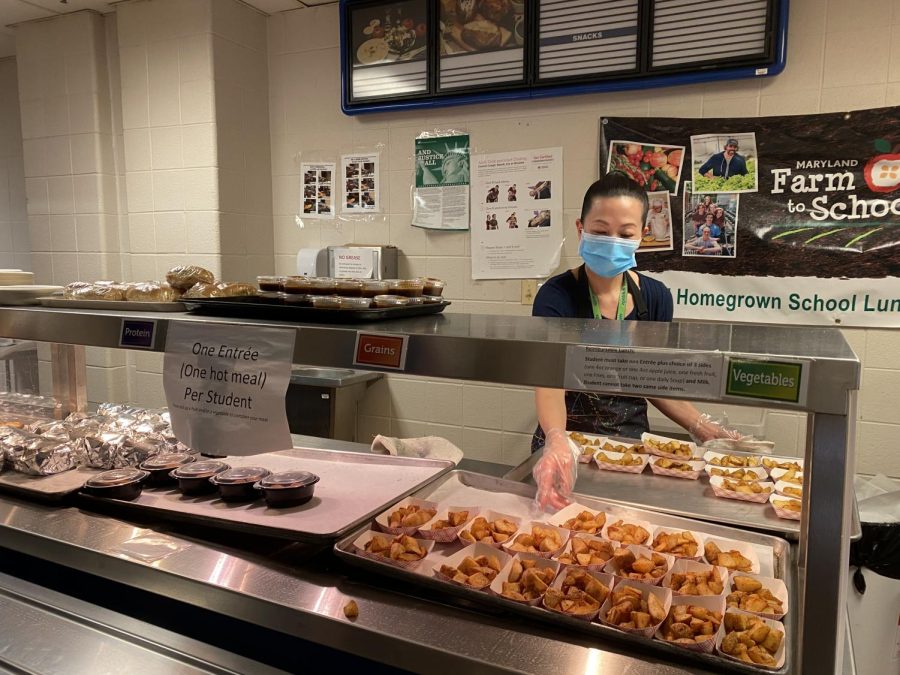MCPS dishes out free lunches to all students
Cafeteria manager Brenda Tam distributes a variety of lunch options to students. Although all options are free, they are required to get a meal and a fruit to make sure they get all of the nutrients they need.
January 2, 2022
Going out to eat, packing a meal from home or buying from the cafeteria have all been long-standing options for students when deciding what to do for lunch. However, much like other aspects of school during the COVID-19 pandemic, this has changed with Montgomery County Public Schools (MCPS) seeking to prevent food insecurity from affecting the success of students in the county.
During the beginning of the pandemic, the United States Department of Agriculture (USDA) granted waivers that allowed counties across the country to provide free and nutritious meals to all students. Utilizing this, MCPS set up food distribution sites that gave food to those in need during the school year and throughout the summer. This decision was recently extended in April to include the 2021-2022 school year, making every meal from the cafeteria free for all students.
“School meals were made free by the federal government for the 2020 school year through the end of this school year,” 44th Student Member of the Board Hana O’Looney said. “But MCPS has a very important role to decide whether or not we want to continue this programming which means that since the federal funding is for emergency pandemic relief, we would be forced to take on that cost if we choose to do so.”
One of O’Looney’s top priorities is to have universally-free lunches included in the 2023 operating budget, which determines how MCPS divides its spending. However, this is not a unilateral decision, and four other board members must agree and vote with her for this to be implemented in the future. The operating budget will be released in the near future, and will determine whether money will be allocated to funding this program.
According to a 2020 study from No Kid Hungry, 18.4 percent of all MCPS middle schoolers and 21.9 percent of MCPS high school students face food insecurity. Beyond that, students of color have a much higher likelihood of facing food insecurity compared to their white peers, with there being a 301 percent difference between white and Latino high school students, in regards to food insecurity. The pandemic has revealed deep-rooted inequities in the school system, from technological accessibility to food insecurity, and O’Looney is working on how to best combat this.
“I think all students should be able to access a hearty healthy meal that keeps them going, that keeps them energized throughout the school day. I don’t think we can expect especially our low income students to perform as well as students who are able to afford their own lunch on an empty stomach,” O’Looney said. “So I really think that school lunches being made free are just an equity issue and making sure that we are all well fed and able to concentrate on schoolwork instead of concentrating on hunger.”
Before the pandemic, only students within a certain income and household size were eligible to receive free and reduced meals (FARMS). Students who did not qualify for this program were expected to pay for the full price of their food despite many of them not being able to afford it. School lunch debt is a rising problem nationwide, with the average debt per food-insecure child in Maryland being $172.82 according to the Education Data Initiative. MCPS focuses on avoiding “lunch shaming,” where students are punished for not being able to afford meals, and has tabled past policies that would force students to eat “alternative meals” such as a sandwich instead of a hot meal if they had over $35 of debt.
“School culture is always the hardest thing to address, or one of the hardest things to to address and make progress on, but I do think that this is a good step in being able to do that,” O’Looney said. “By that I mean is it heard of a lot of schools that I visited that since we’ve been able to make and keep our school lunches free, more students have access to the service of all different socio economic backgrounds, destigmatizing receiving school lunch.”
There are some downsides to this new system however, with students being required to take an entire meal even if they are just looking to eat one specific item, leading to food waste. On the other hand, students are often still hungry after meals, and are unable to go back for a second portion because it is free. The quality of school lunches are also a contention point for many students, as well as the lack of options for students with dietary restrictions.
“I used to get school lunch. They used to have french fries or chicken nuggets and stuff that aren’t like a full [meal] like a burger, but you can eat them as a snack,” WCHS senior Veronica Starchenko said. “But now they don’t have those anymore. So it’s like if you go into the line you have to get a full meal so I don’t buy school lunch anymore.”
Although MCPS still has to work out the kinks with this new program, it ensures that every student is receiving healthy and filling foods no matter their economic status. Universal free lunch is on the table for the county, serving up a slice of success with every meal.
“I think it’s a great idea! Students have access to food regardless of their backgrounds. It is also quickly accessible for all students as the cafeteria is within the school building,” cafeteria manager Brenda Tam said. “Many more students have come by to grab lunch as compared to previous years.”


